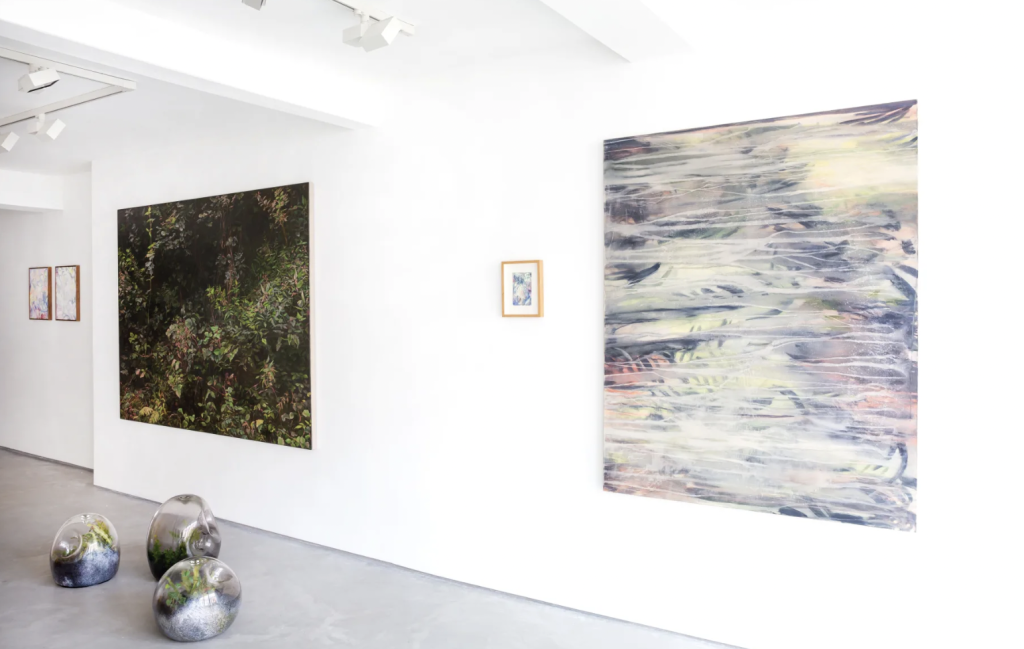Text by Meritxell Rosell

Regeneration is often associated with spring, the appearance of new structures and new futures. However, regeneration can be spiritual as well.
Running until 7 May 2022, Informality, a contemporary art gallery based in Oxfordshire (UK), presents Regeneration. Exhibiting works by eight international artists with multidisciplinary approaches, Regeneration aims to use Richard Taylor’s theory on Fractals as an instruction to investigate how artists and art can scientifically provide us with a way to regenerate.
The exhibition explains that fractals are a concept that was originally coined in 1975 by Polish-born mathematician Benoit Mandelbrot. In his seminal work, The Fractal Geometry of Nature, he defines a fractal as a rough or fragmented geometric shape that can be split into parts, each of which is (at least approximately) a reduced-size copy of the whole.
Essentially, a fractal is a patterned structure repeated at different scales by the laws of nature. For example, think of the leaves, branches and roots of a tree; trees are natural fractals formed by patterns that repeat smaller and smaller copies of themselves to create the biodiversity of a forest. And they regenerate and replicate these fractals.
As with other scientific theories – such as Bohr’s atomic model and the surrealists- Mandelbrot’s theory was later explored in its relationship to art by Taylor, providing an intersection between physics and art using simple mathematical rules to help us understand the laws of imagery that might otherwise read or present as too complex or chaotic. Interestingly, in 1999, an expert on chaos and professor in physics, psychology and art at the University of Oregon published in Nature findings on why Jackson Pollock in the 1950s created a series of abstract works that soothed viewers so much.
In his findings, Taylor found that we relieved stress or otherwise started to regenerate when viewing a mathematical dimension (D) read through our retina of a ratio between 1.3 and 1.5D. In nature, clouds, trees, branches, rivers and foliage are imagery repeating the same ratio as the patterns Taylor examined in Pollock’s series of works created in the 1950s.
Informality curators and directors Frederick McDonald and Zsanett Der-levine share that Regeneration reflects an overall message through the gallery’s programme. It is a personal research topic they hope to uncover through several iterations over the years.

McDonald says he has personally experienced mild forms, but enough to see the physical and mental difference over the years of trying to ascertain a life outdoors in an urban environment, where his interest in biopsychology stemmed. For him, Art, in particular, has helped him deal with my insecurities and anxiety when in urban environments.
My whole life, I have been torn between appreciating great art in cities and enjoying hiking, climbing and the outdoors just as much. As a result, I spend most of my time active and outside; I deeply feel connected and secure in outdoor environments and am looking to explore scientifically why. Mcdonald also believes that art is one of the most important ways to reach an audience and provides an experience from which we can learn.
Similarly, the artists carefully selected exhibiting in Regeneration –Jamie North, Martine Poppe, Virginia Woods-Jack, Rebecca Partridge, Hannah Brown, Laura White, Tamara Dean and Tamsin Relly– present works that are equal in dimension for us to relax scientifically. In addition, the curators give us a few more insights into this process:
The foundations for the exhibition have been ongoing for some time; with the gallery’s programme fully in its existence; I have been researching artists whose works broadly explore topics on the environment, and the artists selected in this exhibition each present work directly can relate to Professor Richard Taylor’s theory. Although this is a personal topic, the biggest challenge whilst curating the show was to work within the restriction of the size of our physical premise, the interest in the show continued to grow. I always think about historical shows that have resonated with me, and I believe that small, impactful shows can share just as meaningful, relevant messages as a large retrospective. I enjoy this restriction, as it can be challenging but extremely rewarding.
Deepening on some of the exhibition’s main concepts, we’ve observed how affect has become a prominent topic in current artistic discourse. In that sense, Regeneration explores the positive impact of the experience of certain patterns and spatial distributions in our moods or sensations. McDonald says that Regeneration offers a visual presentation that uses a theory from the environment to understand the importance of art and culture in what can potentially be seen as an ‘impactful’ topic to humanity.
Conversations and the media extend our already existing uncertainties about our environment, climate change and our future. However, this exhibition isn’t about finding an answer to an existing problem. Instead, its aim is to encourage viewers to see art beyond being a commodity and should be experienced idly, slow and meaningfully, and scientifically. The artworks selected for Regeneration can contribute to this.






